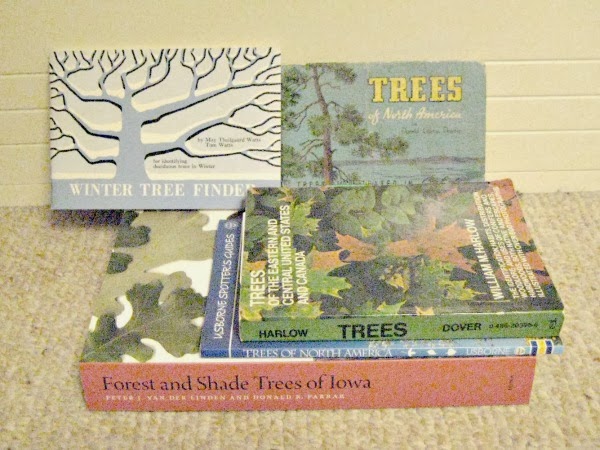A book review
I joined our county conservation board's bookworms (book club) for February, which me think about my nature books. I frequently carry books during our nature walks, but since they are heavy, I tend to be choosy. Here is a snapshot of the tree ID books that I own.
I've reviewed Forest and Shade Trees of Iowa in this post. I would use this book for myself, or when with a person who wants to know the exact, specific tree we find while hiking.
For those who are not in Iowa, or don't need much detail, I would take the slim Trees of North America (Usborne Books).You will find an illustration, name, and very brief description for each listing. Many common trees will be listed in this book. I like the checkboxes (they're actually circles) -- you can make a lifelist by checking the trees you've found and transferring your findings to the scorecard in the back. This activity somewhat "gamifies" identification. Since this book was created with the child in mind, the back of the book contains sections about growing a tree from seed, winter identification, tree rings, bark and bark rubbings, leaf pressing, and Latin names.
If you need more detail, I like Trees of the Eastern and Central United States and Canada, by Harlow. It has black and white photos and line drawings, with very detailed descriptions of all the parts, keyed illustrations, and a lovely section called "Remarks." Remarks separate this book from the Iowa tree book. My general standby North American Wildlife has descriptions and remarks for trees, but is sparser.
As a collector of nature books, I also own Trees of North America -- it's the small hardcover in the upper right hand corner of the photo. It's just OK for identifying trees, but interesting when using the historical perspective of illustration and education. Published in 1934, there is one color photo per tree with a brief description.
Winter Tree Finder is a graphical way to use a dichotomous key. The illustrations are two or one color; the description are graphic, so there isn't much detail. If you have a non-reader accompanying you, this might be a good choice. I find that it is not entirely satisfying to use because you often hit roadblocks. However, it is a small book, so you can easily retrace your steps and start over. It lists Latin names and I LOVE the ruler on the back cover. It's small enough to put in a pocket, too.
Tell me about your tree identification books.


No comments:
Post a Comment